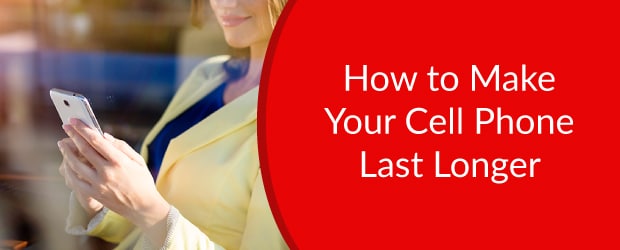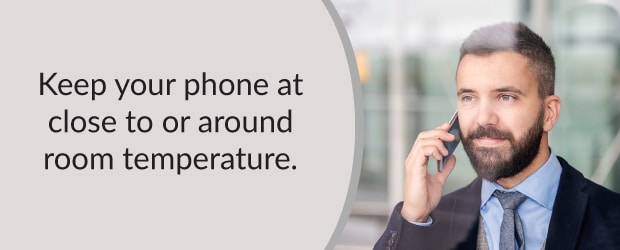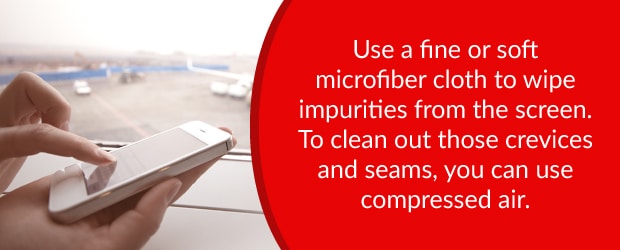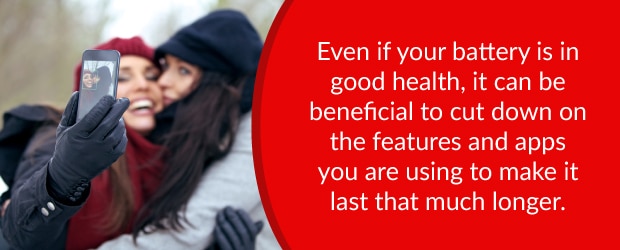
Cell phones are expensive. While some wireless carriers offer subsidized payment plans that significantly lower the buy-in cost of a new phone, many consumers still opt to pay for a phone outright to remain free from contractual obligations.
Even in the case where you don’t buy outright – and you take advantage of that subsidy – a phone can still be more than $200.
When you’re paying upwards of $200 for a device, you want it to last a long time or at the least a reasonable amount of time. If the phone dies on you two to three months down the line, it’s going to cost you a pretty penny. Even with insurance and protection plans, you still have to pay a sizable deductible before you can get your hands on a new device.
Any way you slice it, phones are expensive.
It stands to reason; you don’t want to have to replace yours shortly after getting it. You want it to last as long as possible, at least until you decide to buy something new. Ultimately, that also means making the most of it until enough time has passed, and until you’ve saved up enough for a replacement.
For some, that’s six months to a year. For others, that’s two years or more. Whatever the case, there are some things you can do to ensure your cell phone lasts longer.
How to Make Your Smartphone Last Longer: The Basics
You don’t have to follow all of these tips for taking care of your phone, all the time. However, you certainly want to ensure you take good care of your new — or old — device if you want it to last for a considerable amount of time. Because of that, there are some basic things you should do when you have time.
- Keep your phone clean using a microfiber or soft cloth
- Protect the exterior of your phone with a durable case
- Use a screen protector to keep dust, dirt and scratches away from your display
- Try to keep your phone away from abrasive surfaces or materials, like beach sand
- Unless your phone is waterproof or water-resistant, or you have a protective case then keep it far away from moisture and water
- Don’t use chemicals of any kind to clean the exterior of your device or its display
For some of these points, we will elaborate further later in the guide. You should still ensure that you follow these basic principles to keep your phone safe and healthy.
How to Make Your Phone Last for Years: An In-Depth Guide
These are in no particular order, and all tips are just as important as the next. So, you are free to decide what and when you will follow each tip or guideline.
If you notice something that you haven’t done in a while — or ever — you should probably take note and make sure you take care of it sooner, rather than later. In the end, it’s all up to you.
There is the bonus of being able to sell your phone once you’re done to recoup some of the money you spent on it in the first place. You will always make more if your device is in mint or “like new” condition. It benefits you to take extra special care of your phone, not just so that it lasts longer but also so that you can sell it for more money when you’re done using it.
If you’re interested, the final segment of this guide will discuss selling your used device.
1. Mind the Temperature
Cell phones and smartphones designs encourage use in moderate temperature conditions. If you live in an extreme climate where temperatures change frequently, you might want to figure out a way to keep your phone conservatively tempered.
It’s best to keep the temperature of your phone at a reasonable or warm setting. Keep your phone from becoming hot because it is a mini computer and the phone can overheat – haven’t you ever felt your phone get warm in your hand?

The trick is to keep your phone at close to or around room temperature. Any warmer and you may experience hang-ups, freezes or overheating. If you let it get too cold, it can harm the rechargeable battery inside your phone. Cold temperatures leech the power and energy out of batteries.
One consideration would be where you keep your phone when it’s sitting on a desk or charging at home. If it is in direct sunlight or heat, that’s not good for your cell phone.
2. Handle with Care
Look, sometimes mistakes happen, and you drop your phone, or it slips out of your hand. Hopefully, it doesn’t land on a hard surface, or in a way that it cracks or breaks. Using a durable phone case can help protect your phone if this happens.
There are certain things you never want to do with your phone that put it at risk. That’s why it’s important you handle your expensive device with care. Proper care of a cell phone includes keeping it away from water or liquid in general unless you’re one of the lucky few who has a water-repellent or waterproof device. Still, you’ll want to keep your phone away from deep or murky water, because if you drop it in a lake, for instance, it’s going to be tough to recover.
Keep it dry. If it’s raining or you’re sweating profusely, store the phone in a way that it won’t come into contact with moisture. If you cannot prevent moisture from getting to the phone, it’s best to leave it out of harm’s way. Yes, in some cases that might mean leaving it at home or inside.
When you are handling the phone, be sure to keep a tight grip, so you don’t drop it. You can always purchase a lanyard to wrap around your wrist in the event it falls. Some phones – although not all – include a clip that can be used to wrap the lanyard around.
If you’re handing the phone to someone, never toss it and be sure the other person has a good grip before letting go.
Ultimately, the goal is to cut down on some dangers exposed to your device. Reducing risks may seem obvious, but you’d be surprised how easy it is to overlook some of these things, especially when you’re not overly concerned.
3. Keep It Clean
With hours upon hours of use, devices are exposed to tons of fingerprints and oils, not to mention all the other germs your phone comes into contact with each day. Overall, cell phones can get pretty dirty. Dirt and debris can clutter in speaker holes and indents. Oils can build up in the seams or cracks. It goes on and on.
To make matters worse, you’re often told not to use water or chemicals to clean your device. Not cleaning a device riddled with germs may not make a whole lot of sense. Shouldn’t it be safe to wipe it down with an alcohol wipe or wet wipe?
The answer is no. Don’t use chemicals, alcohol or wipes to clean your device unless you know what you’re doing. You can cause more harm to the device when you try to clean it with chemicals.

Your best bet is to use a fine or soft microfiber cloth to wipe impurities from the screen. To clean out those crevices and seams, you can use compressed air.
If you feel you absolutely must wipe your phone with something there are alternative ways. Mix alcohol and water (40/60) and slightly dampen a cloth or cotton swab. It’s important that you DO NOT soak the cloth or swap in fluids. You merely want it damp enough to wipe the impurities away.
We still recommend avoiding chemicals of any kind.
4. Protect It
Get a case, as soon as possible. It helps to buy a fitted case right when you get the phone, but accessories at a wireless carrier store can be expensive. It makes sense why some people might wait or hold off, but you don’t want to do so for long.
An external case can help protect the entire phone, from the finish and design to the display. Even if you have a shatterproof display or device with tough Gorilla Glass, it’s still possible to break the device. A case will absorb most of the shock on impact rather than your phone.
It can also help protect from things like dirt and dust, fingerprints and oils and more.
If you don’t like how bulky certain cases feel, you can also find thin skins to at least protect the exterior finish of your device. There are a variety of stores and manufacturers that handle this sort of thing.
5. Take Care of the Battery
Without power or energy, your phone is not going to do you much good. If the battery doesn’t last long, that can make things even worse. Because of that, you want to take care of the battery inside your device so that it remains ‘like new’ for as long as possible. Luckily, there are some tips for taking care of your phone battery that you can follow.
Try to refrain from charging the battery often. Every once in a while, it’s okay to charge your phone when it’s not empty, but you don’t want to make this a habit. Let your battery run down as much as possible before charging it fully. If you cannot do this frequently, make it a habit of charging your phone – while it’s off – from low at least once a week.

Charging your phone only when necessary will help it last longer. Why? Rechargeable batteries are usually rated by charge cycles. Every time you recharge your device to full, that’s considered a cycle. The more you do it, the less your battery lasts.
Adversely, it’s important not to let your battery run down to 0% or empty. If it does, you do not want to leave your phone dead for long. Always keep some charge in the battery, and try to cut down on the amount of times you charge it to full.
It’s true, it can be a balancing act, but if you make it a regular habit, you should be able to get through the process without much thinking.
6. Delete Apps and Content You Don’t Need
Believe it or not, the more you have stored on your device, and the more apps you have installed, the more sluggish it’s going to be. Over time, all that gunk can cause performance issues slowing your device down considerably.
There are a couple of things you can do to address this.
For starters, remove any and all content you don’t need. If you have too many apps, start getting rid of the ones you never use. Some tools will provide recommendations for apps to remove.
If your phone is full of photos or videos, you can upload them to a personal cloud storage service like Google Drive, Apple iCloud or Dropbox. Then simply remove the local content from your device. Most of these services have mobile apps that you can use to browse your stored content from anywhere. You won’t lose access to your photos and videos and yet you have tons more space on your phone.
Over time, some apps build up large caches of data – the Facebook app is a great example – and it’s beneficial to either clear this data or uninstall and reinstall the app completely. On Android, you can navigate to Settings > Storage and tap the ‘Cached Data’ option to get the prompt to clear it. On iOS, you can simply uninstall the app and reinstall. Either way, pretty simple.
7. Make Your Battery Last Longer

Even if your battery is in good health, it can be beneficial to cut down on the features and apps you are using to make it last that much longer. Using this technique is especially useful if you’re going on a long trip and you need your phone to last, but there won’t be a charging source nearby.
You can always opt for a portable battery pack or charging adapter that gives you extra juice, but there are some things you can do on your phone too.
Make sure you turn off Wi-Fi, Bluetooth, location services and mobile connectivity when applicable. You can disable any and all incoming data on your device in areas where there are little to no service.
Also, try to cut down on the number of apps that are running. Both Android and iOS do an excellent job of multitasking and suspending various apps, but there are still services that run in the background. If you don’t use it regularly, lose it. Social media apps like Facebook and Twitter are notorious for using more energy and power.
On Android, try to stay away from task manager and memory management apps. It’s a common misconception that these can help improve performance and battery life, that’s not the case. Always killing apps and restarting them uses more power. Not to mention it hinders the natural process of the operating system. Android is designed from the ground up to be efficient with this stuff, especially the new versions.
What to do With Your Phone When You’re Done with It: Recycle
You’d be surprised how many people toss their old device in a drawer and let it rot. What’s the point, especially if you’re never going to use it again?
Sometimes it is beneficial to keep a backup in case something goes wrong, but in most cases, you’ll probably end up buying a new phone or replacement anyway. So, what do you do with your old phone?
Recycle it! No, not the recycling where it’s parsed down for scrap, though that’s always an option too.
The recycling where you give your old device a new home and a new owner. If you’ve done a great job of taking care of it, then chances are someone else would love to have it! There are so many different options for reselling and getting more out of your phone, even when you’re all finished with it!
It lasted you a long time and treated you well – and vice versa – why not pass the torch to someone else? The Whiz Cells is a great marketplace for reselling your device, and you can do it through their site or eBay, whichever you prefer.
